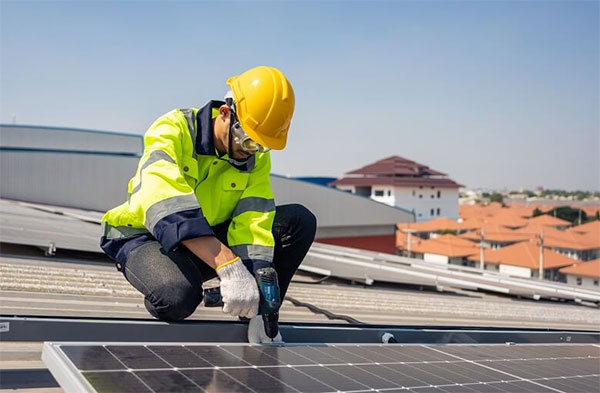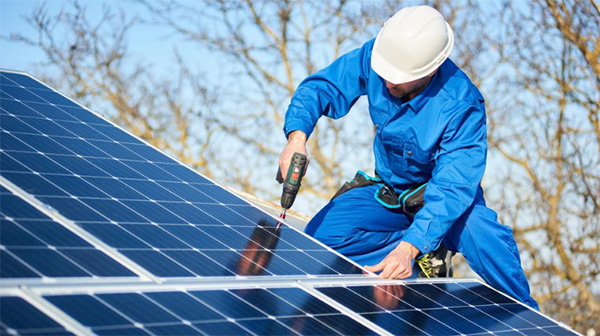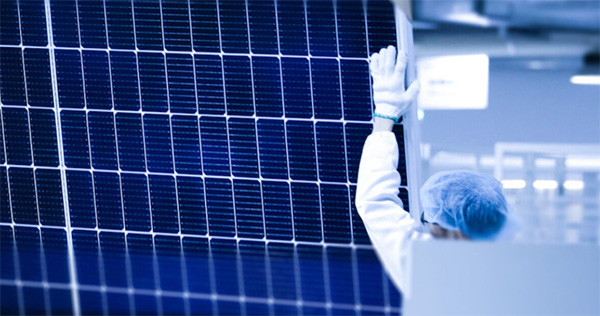Description
Tongwei offers a range of solar panels to cater to various energy needs and preferences. The different types of solar panels provided by Tongwei include Monocrystalline Silicon Cells, Polycrystalline Silicon Cells, Half-Cut Solar Panels, and Shingled Solar Panels.
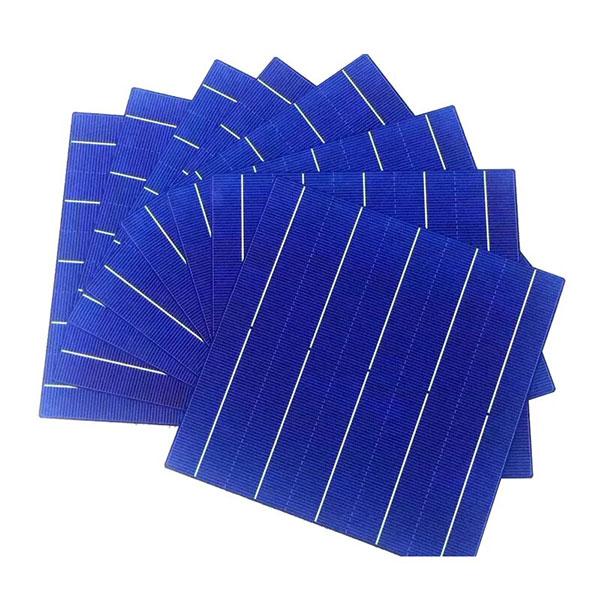
Monocrystalline Silicon Cells
Monocrystalline silicon cells, often dubbed the "premium" solar product, are known for their high efficiency and sleek appearance. These cells derive their name from the single, continuous crystal lattice structure, making them easily distinguishable from other types of solar cells. Typically, these cells present a black hue due to the way they absorb sunlight.
Definition and Features
Monocrystalline silicon cells are created from a single crystal of silicon. Unlike their polycrystalline counterparts, which are formed from multiple silicon fragments melted together, monocrystalline cells are sliced from a single, pure silicon crystal.
- Purity: The purity of the silicon used in these cells is exceptionally high, resulting in a consistent appearance and improved efficiency.
- Size: Typically, these solar cells measure about 156mm x 156mm in size.
- Efficiency: One of the standout features is their high efficiency. Monocrystalline solar cells often achieve efficiency levels between 20-22%.
- Temperature Coefficient: Their temperature coefficient is around -0.3%/°C. This means for every 1°C above 25°C, the efficiency drops by 0.3%.
Advantages and Disadvantages
Advantages:
- Peak Efficiency: As mentioned, monocrystalline cells boast some of the highest efficiency levels in the solar industry. Their high silicon purity plays a significant role in this.
- Space Efficiency: Due to their high power output, fewer panels are needed to generate the same amount of electricity, making them ideal for spaces with limited area.
- Longevity: Monocrystalline panels have an impressive lifespan. With proper care, they can last upwards of 25 years, retaining a substantial amount of their original efficiency.
- Aesthetic Appeal: Their uniform black color offers a sleek and modern appearance, preferred by many homeowners for its aesthetic appeal.
Disadvantages:
- Cost: The price is one of the primary drawbacks. Monocrystalline solar panels tend to be more expensive than polycrystalline panels due to the cost of producing pure silicon wafers.
- Waste: The process of creating these panels involves cutting cylindrical ingots to form the square shape of the solar cell, leading to wasted silicon.
Applications and Suitability
Monocrystalline silicon cells are versatile and can be used in a myriad of applications. Their high efficiency makes them particularly suitable for urban settings where roof space might be limited. They are a popular choice for residential rooftop installations, commercial establishments, and even in some
large-scale solar farms. Given their long lifespan and consistent performance, they are also deemed an excellent choice for long-term solar projects and investments.
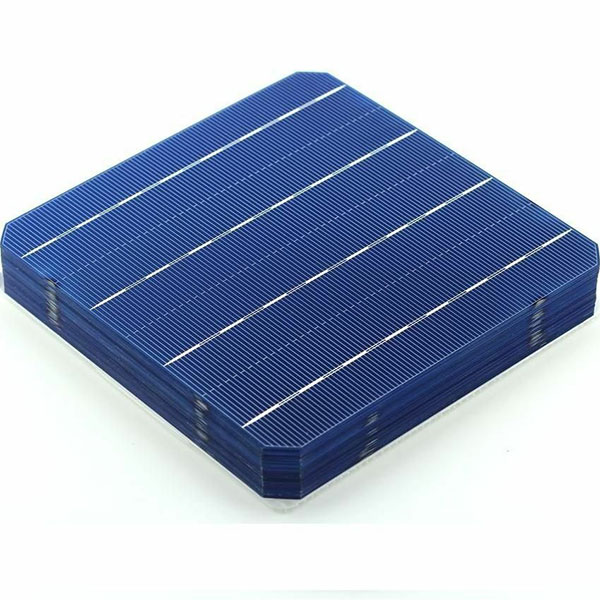
Polycrystalline Silicon Cells
Emerging as a cost-effective alternative to monocrystalline cells, polycrystalline silicon cells have carved their niche in the solar industry. Characterized by their bluish hue and somewhat grainy appearance, they offer a unique blend of performance and affordability.
Definition and Features
Polycrystalline silicon cells, also known as multi-crystalline cells, are manufactured by melting multiple silicon fragments together. These cells are formed when liquid silicon cools and solidifies into multiple crystals within a single cell.
- Appearance: Unlike the uniform appearance of monocrystalline cells, polycrystalline cells showcase a mosaic-like structure, giving them their distinctive blue color.
- Size: These cells are usually found in the standard size of 156mm x 156mm, similar to their monocrystalline counterparts.
- Efficiency: Polycrystalline cells generally have efficiency rates ranging from 15-17%.
- Temperature Coefficient: They possess a temperature coefficient of about -0.35%/°C, indicating a slightly higher efficiency drop with increasing temperature compared to monocrystalline cells.
Advantages and Disadvantages
Advantages:
- Cost-effective: Polycrystalline panels are generally less expensive to produce, resulting in a lower price point for consumers. On average, the cost per watt might hover around $0.18, making it a tad cheaper than monocrystalline panels.
- Manufacturing Process: The production process for these panels is simpler and results in less silicon wastage, contributing to their cost-effectiveness.
- Durability: Just like monocrystalline cells, these panels can last for 25 years or more with proper maintenance.
Disadvantages:
- Lower Efficiency: While the difference might not be massive, polycrystalline cells tend to have a slightly lower efficiency rate compared to monocrystalline cells.
- Space: Due to their lower efficiency, more panels might be required to produce the same amount of electricity, potentially requiring more installation space.
- Aesthetics: Some users might find the blue, grainy appearance less appealing compared to the sleek black look of monocrystalline panels.
Applications and Suitability
Polycrystalline silicon cells, due to their cost-effectiveness, find their application in a range of settings. They're frequently used in residential solar installations, especially in regions where the cost might be a more significant deciding factor than efficiency. Additionally, they're also found in
community solar projects and larger solar installations where ample space is available. Given their balance between price and performance, polycrystalline solar panels prove to be a robust choice for those looking to harness solar energy without breaking the bank.

Half-Cut Solar Panels
As the solar industry constantly innovates, half-cut solar panels have emerged as a noteworthy advancement. These panels are designed to boost efficiency and performance, especially in partial shade conditions, and are gaining traction for both residential and commercial installations.
What are Half-Cut Solar Panels?
Half-cut solar panels are essentially what their name suggests. Traditional solar cells are cut in half using a laser, resulting in two smaller cells from a single standard cell. These smaller cells then work in parallel, reducing the current passing through each cell.
- Design: Instead of the standard 60 cells, a half-cut panel might contain 120 half-sized cells. The layout remains similar, but each cell carries half the current of a full-sized cell.
- Efficiency: The process of halving the cells reduces resistive losses in the panel, leading to an increase in overall efficiency.
Benefits of Using Half-Cut Panels
Efficiency in Shaded Conditions: One of the significant advantages of half-cut panels is their performance under partial shading. Traditional panels can lose a considerable amount of power if even a small section is shaded. Half-cut panels, due to their design, can mitigate this loss, making them more efficient in real-world conditions.
Reduced Power Loss: The electrical current is halved in these panels, which means the resistive losses (proportional to the square of the current) are reduced, leading to an increase in overall efficiency.
Durability and Longevity: With lower resistive losses, the panels tend to heat up less, which can extend their lifespan and maintain their performance over the years.
Enhanced Performance: Studies have shown that half-cut panels can provide 2-3% more power than traditional panels, which might not sound like much, but over the lifespan of a solar installation, it can result in significant additional energy production.
Comparisons with Traditional Solar Panels
Efficiency: While traditional solar panels have efficiency rates ranging between 15-20%, half-cut panels can push this number slightly higher, often reaching efficiency levels of 21-23%.
Cost: Initially, the laser cutting process added to the cost of production, making half-cut panels slightly more expensive. However, with advancements in manufacturing techniques, the price difference between traditional and half-cut panels has been narrowing. On average, the cost might be around $0.22 per watt for half-cut panels.
Space: Due to their enhanced efficiency, fewer half-cut panels might be required to generate the same amount of electricity, potentially offering space savings for installations.
Resilience to Shading: As mentioned earlier, one of the standout features of half-cut panels is their resilience to shading. In scenarios where shadows from trees, chimneys, or other obstructions might be a concern, half-cut panels offer a clear advantage.
In conclusion, half-cut solar panels represent an exciting step forward in the evolution of solar technology. Their design and features make them an attractive option for a variety of installations, from urban rooftops to expansive solar farms. As the solar industry continues to innovate, solutions like these bring us closer to a more sustainable and energy-efficient future.
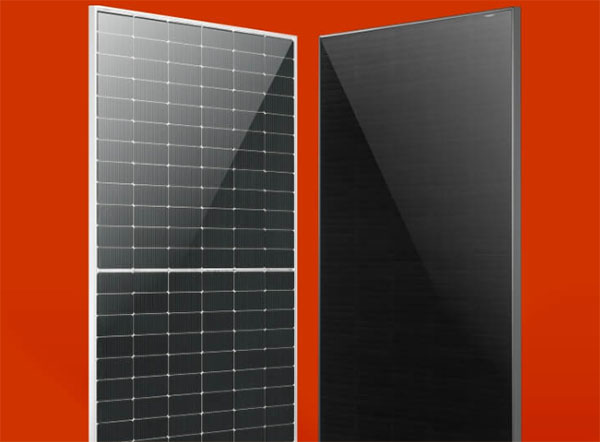
Shingled Solar Panels
With the quest for increasing efficiency and reducing costs, the solar industry continually seeks innovative solutions. One such intriguing development is the shingled solar panel, a unique design approach that aligns solar cells in an overlapping manner, much like roof shingles.
Understanding Shingled Solar Panels
Shingled solar panels use standard monocrystalline or polycrystalline solar cells, which are then sliced into narrow strips. These strips are overlapped in a consecutive row, eliminating the need for typical inter-cell spacing.
- Design: The shingled design aims to utilize more of the panel surface for capturing sunlight, leading to an increased power output.
- Efficiency Boost: By reducing inactive spaces on the panel and optimizing the active solar cell area, shingled panels can achieve higher efficiency rates.
- Assembly: The overlapped cell strips are interconnected using conductive adhesives, a method different from the traditional busbar connections.
Advantages of Shingled Panels
Enhanced Efficiency: Shingled panels can produce approximately 5-10% more electricity than their traditional counterparts. This enhancement can lead to an efficiency rate of up to 22%, depending on the base cell used.
Space Optimization: With fewer gaps and more active cell area, shingled panels are better at maximizing the energy generation potential of a given space.
Aesthetic Appeal: The lack of visible busbars and a more uniform appearance can be more visually appealing to some homeowners or businesses, making shingled panels a stylish choice.
Reduced Power Loss: By minimizing the gaps between cells, shingled panels reduce resistive losses, which can lead to better performance, especially in high-temperature conditions.
Cost Efficiency: As manufacturing techniques improve, the price of shingled panels is expected to become competitive, hovering around $0.24 per watt.
Potential Limitations
Heat Dissipation: Overlapping cells can sometimes lead to heat retention issues. While this is often mitigated by improved designs and materials, it's a factor to consider, especially in very hot climates.
New Technology Concerns: Being a relatively newer design, there might be uncertainties regarding long-term performance, degradation rates, and potential maintenance needs.
Weight: Due to the added layers of cells, shingled panels might be slightly heavier than traditional panels, potentially requiring more robust mounting structures.
In summary, shingled solar panels represent an innovative leap in photovoltaic technology. Offering enhanced efficiency and a fresh aesthetic appeal, they might become a preferred choice for many in the near future. However, as with all new technologies, thorough research and consultation with industry experts are advised before making an investment decision.
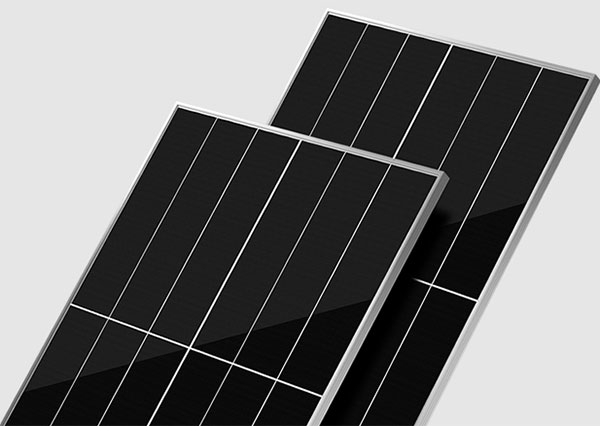
Comparative Analysis
In the realm of solar panels, informed choices are pivotal. It's essential to understand the nuances of different types of solar panels, particularly when considering factors like efficiency, cost, and durability. Let's delve deep into a comparative analysis of the different types of panels discussed.
Efficiency Comparison
One of the primary factors people consider when selecting a solar panel type is its efficiency – how well the panel converts sunlight into electricity.
| Solar Panel Type |
Efficiency Rate |
Key Takeaway |
| Monocrystalline |
20-25% |
Known for high efficiency due to the purity of silicon used. |
| Polycrystalline |
15-20% |
Slightly lower efficiency but often more affordable. |
| Half-Cut |
21-23% |
Improved design reduces resistive losses boosting efficiency. |
| Shingled |
Up to 22% |
Overlapping cells maximize panel surface for sunlight capture. |
Cost-effectiveness Analysis
While efficiency is paramount, the cost plays a significant role, especially when considering the return on investment and payback period.
| Solar Panel Type |
Average Cost per Watt |
Key Takeaway |
| Monocrystalline |
$0.26 |
Higher initial cost but can offer long-term savings due to efficiency. |
| Polycrystalline |
$0.23 |
A budget-friendly option with decent performance. |
| Half-Cut |
$0.22 |
Reduced production costs make it competitive. |
| Shingled |
$0.24 |
Newer technology but prices are falling as demand rises. |
Longevity and Durability
The lifespan of a solar panel determines its value over time. Most panels come with a 25-year warranty, but their actual lifespan and performance degradation rate can vary.
| Solar Panel Type |
Expected Lifespan |
Annual Degradation Rate |
Key Takeaway |
| Monocrystalline |
25-30 years |
0.3-0.5% |
Stable with minimal degradation. |
| Polycrystalline |
25-28 years |
0.4-0.6% |
Slightly higher degradation rate. |
| Half-Cut |
26-30 years |
0.3-0.4% |
Improved design extends lifespan. |
| Shingled |
25-28 years |
0.4-0.5% |
Overlapping might affect longevity slightly. |
In conclusion, while each solar panel type has its advantages and potential drawbacks, the choice often boils down to individual priorities. Whether it's the highest efficiency, the best value for money, or a balance between the two, the above analysis aims to provide a clearer picture to make an informed decision. Always consult with a solar expert to tailor the best solution for specific needs.






